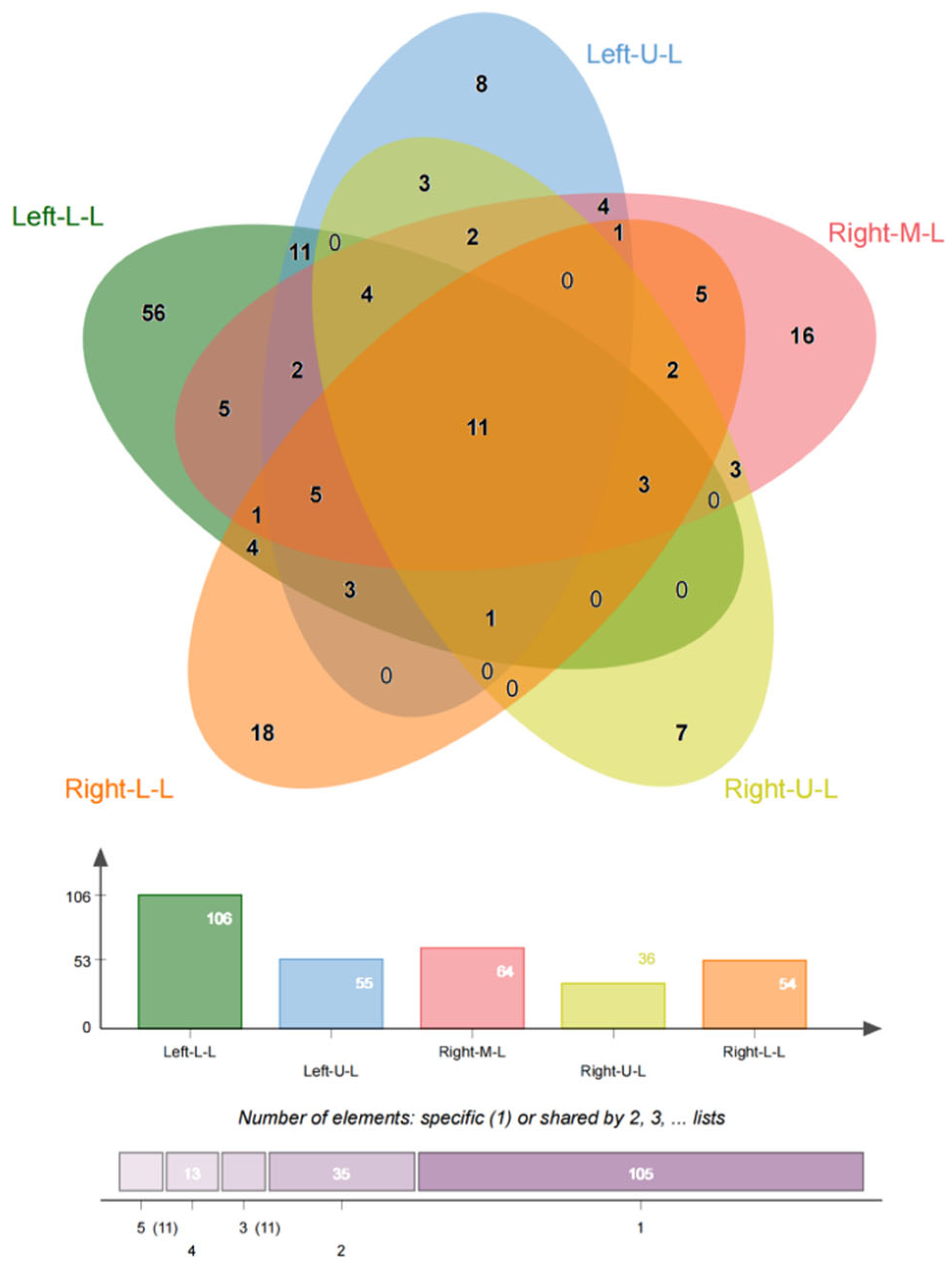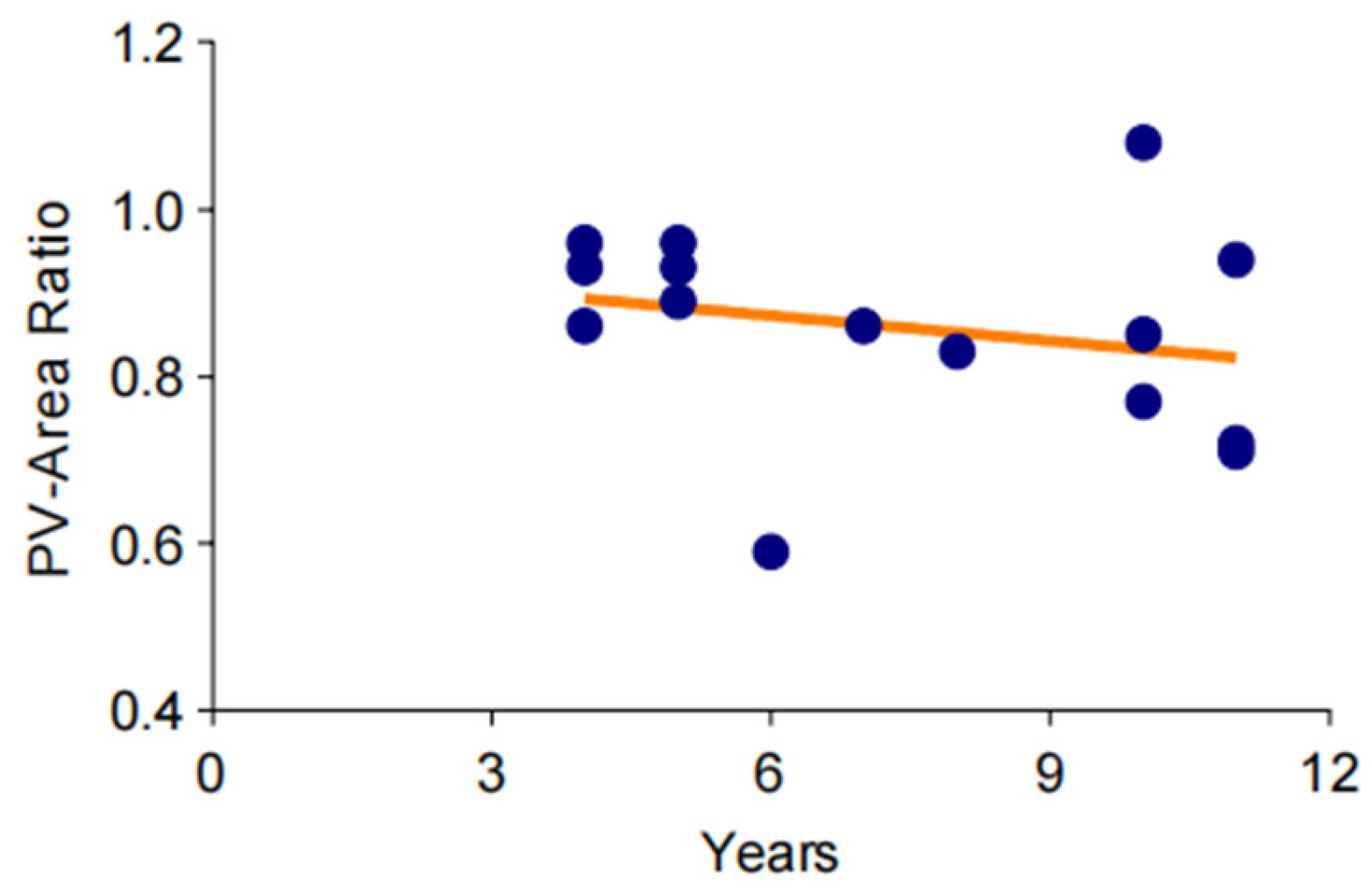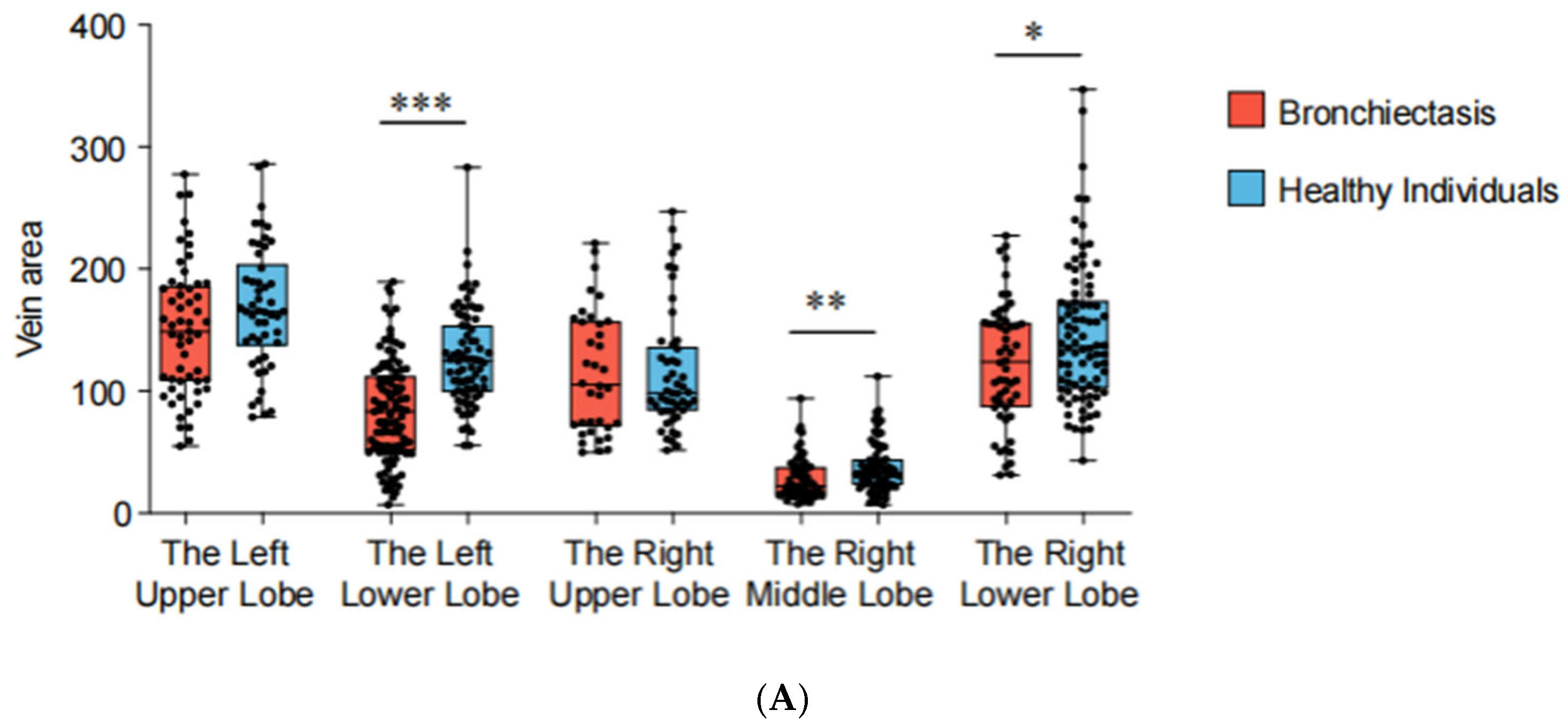Prevalence and Clinical Implications of Pulmonary Vein Stenosis in Bronchiectasis: A 3D Reconstruction CT Study
Abstract
Highlights
- Significant prevalence of pulmonary vein stenosis (PVS) in bronchiectasis patients, particularly in the left lower lobe.
- Pulmonary vein stenosis is associated with disease progression, reduced lung volume, and impaired lung function in bronchiectasis patients.
- Pulmonary vein stenosis in bronchiectasis has been identified and statistically analyzed for the first time, providing a new direction for future research on bronchiectasis.
- Pulmonary vein stenosis may be an important factor in the progression of bronchiectasis and a potential therapeutic target.
Abstract
1. Introduction
2. Methods
2.1. Study Population and Design
2.2. The Definitions for Study Variables and Outcomes
2.3. Three-Dimensional Reconstruction
2.4. Statistical Methods
3. Results
3.1. Baseline Characteristics
3.2. Pulmonary Venous Stenosis Found in the Bilateral Lower Lobes and Middle Lobe of Patients with Bronchiectasis
3.3. Trend of Gradual Aggravation of Pulmonary Venous Stenosis in a Long-Term Observation
3.4. Reduced Lung Function in Bronchiectasis, Owing to Left Lower Lobe Cases
4. Discussion
5. Conclusions
Author Contributions
Funding
Institutional Review Board Statement
Informed Consent Statement
Data Availability Statement
Conflicts of Interest
References
- Chandrasekaran, R.; Mac Aogáin, M.; Chalmers, J.D.; Elborn, S.J.; Chotirmall, S.H. Geographic variation in the aetiology, epidemiology and microbiology of bronchiectasis. BMC Pulm. Med. 2018, 18, 83. [Google Scholar] [CrossRef]
- Gómez-Olivas, J.D.; Oscullo, G.; Martínez-García, M. Etiology of Bronchiectasis in the World: Data from the Published National and International Registries. J. Clin. Med. 2023, 12, 5782. [Google Scholar] [CrossRef] [PubMed]
- O’donnell, A.E. Bronchiectasis—A Clinical Review. N. Engl. J. Med. 2022, 387, 533–545. [Google Scholar] [CrossRef] [PubMed]
- Chalmers, J.D.; Chang, A.B.; Chotirmall, S.H.; Dhar, R.; McShane, P.J. Bronchiectasis. Nat. Rev. Dis. Prim. 2018, 4, 45. [Google Scholar] [CrossRef] [PubMed]
- Dodd, J.D.; Souza, C.A.; Müller, N.L. Conventional High-Resolution CT Versus Helical High-Resolution MDCT in the Detection of Bronchiectasis. Am. J. Roentgenol. 2006, 187, 414–420. [Google Scholar] [CrossRef]
- Gürel, E.; Vezir, D.; Guctekin, T.; Dogan, Z.; Kocakaya, D.; Olgun, S.; Sunbul, M.; Cincin, A.; Ozben, B.; Sayar, N.; et al. The Impact of Cystic Fibrosis- and Noncystic Fibrosis-Bronchiectasis on Pulmonary Artery Wall Thickness and Right Heart Functions Assessed by Speckle-Tracking Echocardiography. Anatol. J. Cardiol. 2023, 27, 319–327. [Google Scholar] [CrossRef]
- Liebow, A.; Hales, M.R.; Lindskog, G. Enlargement of the bronchial arteries, and their anastomoses with the pulmonary arteries in bronchiectasis. Am. J. Pathol. 1949, 25, 211–231. [Google Scholar]
- Steinberg, I.; Lyons, H.A. Ipsilateral hypoplasia of a pulmonary artery in advanced bronchiectasis. Am. J. Roentgenol. Radium. Ther. Nucl. Med. 1967, 101, 939–946. [Google Scholar] [CrossRef]
- Pazos-López, P.; García-Rodríguez, C.; Guitián-González, A.; Paredes-Galán, E.; Álvarez-Moure, M.A.; Rodríguez-Álvarez, M.; Baz-Alonso, J.A.; Teijeira-Fernández, E.; Calvo-Iglesias, F.E.; Íñiguez-Romo, A. Pulmonary vein stenosis: Etiology, diagnosis and management. World J. Cardiol. 2016, 8, 81–88. [Google Scholar] [CrossRef]
- Rostamian, A.; Narayan, S.M.; Thomson, L.; Fishbein, M.; Siegel, R.J. The incidence, diagnosis, and management of pulmonary vein stenosis as a complication of atrial fibrillation ablation. J. Interv. Card. Electrophysiol. 2014, 40, 63–74. [Google Scholar] [CrossRef]
- Ekanem, E.; Neuzil, P.; Reichlin, T.; Kautzner, J.; van der Voort, P.; Jais, P.; Chierchia, G.-B.; Bulava, A.; Blaauw, Y.; Skala, T.; et al. Safety of pulsed field ablation in more than 17,000 patients with atrial fibrillation in the MANIFEST-17K study. Nat. Med. 2024, 30, 2020–2029. [Google Scholar] [CrossRef] [PubMed]
- Zhao, Y.; Yi, X. Safety of different therapies for atrial fibrillation: A network meta-analysis. Curr. Probl. Cardiol. 2024, 49, 102795. [Google Scholar] [CrossRef] [PubMed]
- Jia, M.; Su, H.; Jiang, K.; Wang, A.; Guo, Z.; Zhu, H.; Zhang, F.; Sun, X.; Shi, Y.; Pan, X.; et al. Incidence and predictors of in-stent restenosis following intervention for pulmonary vein stenosis due to fibrosing mediastinitis. Orphanet J. Rare Dis. 2024, 19, 379. [Google Scholar] [CrossRef] [PubMed]
- Gomes, M.; Bendaoud, S.; Wemeau-Stervinou, L.; Faivre, J.-B.; Duhamel, A.; Wallaert, B.; Remy, J.; Remy-Jardin, M. Prevalence of Venoatrial Compression by Lymphadenopathy in Sarcoidosis. J. Thorac. Imaging 2015, 30, 268–273. [Google Scholar] [CrossRef]
- Hamzeh, I.; Rashid, A.; Shaib, F.; Dawn, B. Pulmonary vein stenosis due to a compressive malignant tumor detected by transesophageal echocardiography. Circulation 2011, 123, 349–350. [Google Scholar] [CrossRef]
- Pazos-López, P.; Piñeiro-Portela, M.; Bouzas-Mosquera, A.; Peteiro-Vázquez, J.; Vázquez-Gonzalez, N.; Rueda-Nuñez, F.; Duro-Tacón, J.; Fernández-Prado, R.; Martínez-Sapiña, M.J.; Castro-Beiras, A. Images in cardiovascular disease. Pulmonary Vein Stenosis After Lung Transplantation Successfully Treated with Stent Implantation. Circulation 2010, 122, 2745–2747. [Google Scholar] [CrossRef]
- Braun, S.; Platzek, I.; Zöphel, K.; Weise, M.; Kolditz, M.; Halank, M.; Hoeffken, G. Haemoptysis due to pulmonary venous stenosis. Eur. Respir. Rev. 2014, 23, 170–179. [Google Scholar] [CrossRef]
- Ernst, S.; Ouyang, F.; Goya, M.; Löber, F.; Schneider, C.; Hoffmann-Riem, M.; Schwarz, S.; Hornig, K.; Müller, K.; Antz, M.; et al. Total pulmonary vein occlusion as a consequence of catheter ablation for atrial fibrillation mimicking primary lung disease. J. Cardiovasc. Electrophysiol. 2003, 14, 366–370. [Google Scholar] [CrossRef]
- Kluge, A.; Dill, T.; Ekinci, O.; Hansel, J.; Hamm, C.; Pitschner, H.F.; Bachmann, G. Decreased pulmonary perfusion in pulmonary vein stenosis after radiofrequency ablation: Assessment with dynamic magnetic resonance perfusion imaging. Chest 2004, 126, 428–437. [Google Scholar] [CrossRef]
- Roman, K.S.; Kellenberger, C.J.; Macgowan, C.K.; Coles, J.; Redington, A.N.; Benson, L.N.; Yoo, S.-J. How is pulmonary arterial blood flow affected by pulmonary venous obstruction in children? A phase-contrast magnetic resonance study. Pediatr. Radiol. 2005, 35, 580–586. [Google Scholar] [CrossRef]
- Winant, A.J.; Vargas, S.O.; Jenkins, K.J.; Callahan, R.; Rameh, V.; Krone, K.A.; Johnston, P.R.; Keochakian, M.L.; Lee, E.Y. Pleuropulmonary MDCT Findings: Comparison between Children with Pulmonary Vein Stenosis and Prematurity-Related Lung Disease. Children 2022, 9, 355. [Google Scholar] [CrossRef] [PubMed]
- Lee, E.Y.; Callahan, R.; Vargas, S.O.; Jenkins, K.J.; Park, H.J.; Gauthier, Z.; Winant, A.J. Extravascular MDCT Findings of Pulmonary Vein Stenosis in Children with Cardiac Septal Defect. Children 2021, 8, 667. [Google Scholar] [CrossRef] [PubMed]
- Tiddens, H.A.; Meerburg, J.J.; van der Eerden, M.M.; Ciet, P. The radiological diagnosis of bronchiectasis: What’s in a name? Eur. Respir. Rev. 2020, 29, 190120. [Google Scholar] [CrossRef] [PubMed]
- Aliberti, S.; Goeminne, P.C.; E O’Donnell, A.; Aksamit, T.R.; Al-Jahdali, H.; Barker, A.F.; Blasi, F.; Boersma, W.G.; Crichton, M.L.; De Soyza, A.; et al. Criteria and definitions for the radiological and clinical diagnosis of bronchiectasis in adults for use in clinical trials: International consensus recommendations. Lancet Respir. Med. 2022, 10, 298–306. [Google Scholar] [CrossRef] [PubMed]
- Vidaillac, C.; Chotirmall, S.H. Pseudomonas aeruginosa in bronchiectasis: Infection, inflammation, and therapies. Expert Rev. Respir. Med. 2021, 15, 649–662. [Google Scholar] [CrossRef]
- Flume, P.A.; Chalmers, J.D.; Olivier, K.N. Advances in bronchiectasis: Endotyping, genetics, microbiome, and disease heterogeneity. Lancet 2018, 392, 880–890. [Google Scholar] [CrossRef]
- Kanter, K.R.; Kirshbom, P.M.; Kogon, B.E. Surgical Repair of Pulmonary Venous Stenosis: A Word of Caution. Ann. Thorac. Surg. 2014, 98, 1687–1692. [Google Scholar] [CrossRef]
- Feins, E.N.; Ireland, C.; Gauvreau, K.; Chávez, M.; Callahan, R.; Jenkins, K.J.; Baird, C.W. Pulmonary vein stenosis: Anatomic considerations, surgical management, and outcomes. J. Thorac. Cardiovasc. Surg. 2022, 163, 2198–2207.e3. [Google Scholar] [CrossRef]
- Tekbas, G.; Gumus, H.; Onder, H.; Ekici, F.; Hamidi, C.; Tekbas, E.; Gulicetincakmak, M.; Yavuz, C.; Bilici, A. Evaluation of pulmonary vein variations and anomalies with 64 slice multi detector computed tomography. Wien. Klin. Wochenschr. 2011, 124, 3–10. [Google Scholar] [CrossRef]
- Dillman, J.R.; Yarram, S.G.; Hernandez, R.J. Imaging of Pulmonary Venous Developmental Anomalies. Am. J. Roentgenol. 2009, 192, 1272–1285. [Google Scholar] [CrossRef]
- Marom, E.M.; Herndon, J.E.; Kim, Y.H.; McAdams, H.P. Variations in Pulmonary Venous Drainage to the Left Atrium: Implications for Radiofrequency Ablation. Radiology 2004, 230, 824–829. [Google Scholar] [CrossRef] [PubMed]
- Snellen, H.A.; Ingen, H.C.; Hoefsmit, E.C.M. Patterns of Anomalous Pulmonary Venous Drainage. Circulation 1968, 38, 45–63. [Google Scholar] [CrossRef] [PubMed]
- Kojodjojo, P.; Wong, T.; Wright, A.R.; Kon, O.M.; Oldfield, W.; Kanagaratnam, P.; Davies, D.W.; Peters, N.S. Pulmonary venous stenosis after treatment for atrial fibrillation. BMJ 2008, 336, 830–832. [Google Scholar] [CrossRef]
- Pietra, G.G.; Capron, F.; Stewart, S.; Leone, O.; Humbert, M.; Robbins, I.M.; Reid, L.M.; Tuder, R. Pathologic assessment of vasculopathies in pulmonary hypertension. J. Am. Coll. Cardiol. 2004, 43, S25–S32. [Google Scholar] [CrossRef]
- Latson, L.A.; Prieto, L.R. Congenital and Acquired Pulmonary Vein Stenosis. Circulation 2007, 115, 103–108. [Google Scholar] [CrossRef]
- Saha, B.K.; Chong, W.H. Diffuse Alveolar Hemorrhage in Cardiac Diseases. Lung 2021, 199, 103–112. [Google Scholar] [CrossRef]
- Tokuda, M.; Ogawa, T.; Tokutake, K.; Yamashita, S.; Yoshimura, M.; Yamane, T. Comprehensive review of pulmonary vein stenosis post-atrial fibrillation ablation: Diagnosis, management, and prognosis. Cardiovasc. Interv. Ther. 2024, 39, 412–420. [Google Scholar] [CrossRef]
- Horvath, I.; Loukides, S.; Wodehouse, T.; Kharitonov, S.A.; Cole, P.J.; Barnes, P.J. Increased levels of exhaled carbon monoxide in bronchiectasis: A new marker of oxidative stress. Thorax 1998, 53, 867–870. [Google Scholar] [CrossRef]
- Humpl, T.; Fineman, J.; Qureshi, A.M. The many faces and outcomes of pulmonary vein stenosis in early childhood. Pediatr. Pulmonol. 2021, 56, 649–655. [Google Scholar] [CrossRef]
- Nasr, V.G.; Callahan, R.; Wichner, Z.; Odegard, K.C.; DiNardo, J.A. Intraluminal Pulmonary Vein Stenosis in Children: A “New” Lesion. Anesthesia Analg. 2019, 129, 27–40. [Google Scholar] [CrossRef]
- Almakadma, A.H.; Sarma, D.; Hassett, L.; Miranda, W.; Alkhouli, M.; Reeder, G.S.; Munger, T.M.; Packer, D.L.; Simard, T.; Holmes, D.R., Jr. Pulmonary Vein Stenosis—Balloon Angioplasty Versus Stenting: A Systematic Review and Meta-Analysis. JACC Clin. Electrophysiol. 2022, 8, 1323–1333. [Google Scholar] [CrossRef]
- Feins, E.N.; Callahan, R.; Baird, C.W. Pulmonary Vein Stenosis—Evolving Surgical Management of a Challenging Disease. Children 2021, 8, 631. [Google Scholar] [CrossRef]






| Bronchiectasis (n = 174) | Healthy Individuals (n = 91) | p-Value | |
|---|---|---|---|
| Age, median (range), years | 56 (21–85) | 57 (29–72) | 0.935 |
| Gender, male (%) | 72 (41.4) | 23 (30.7) | 0.110 |
| BMI, M ± SD, kg/m2 | 22.94 ± 3.24 | 23.69 ± 2.95 | 0.085 |
| Smoking, n (%) | 37 (21.3) | 11 (14.7) | 0.226 |
| Hypertension, n (%) | 47 (27.0) | 20 (26.7) | 0.955 |
| Diabetes, n (%) | 19 (10.9) | 8 (10.7) | 0.953 |
| Pulmonary Function | |||
| FEV1, median (range), L | 2.35 (0.65–4.25) | 2.57 (1.24–4.83) | 0.001 |
| FEV1, median (range), %, | 90.40 (28.70–130.90) | 107.20 (61.60–143.40) | <0.001 |
| FVC, median (range), L | 3.10 (1.38–5.11) | 3.33 (1.86–6.10) | 0.015 |
| FEV1/FVC, median(range), % | 75.50 (38.70–166.80) | 78.45 (56.81–144.40) | <0.001 |
| Bronchiectasis | Health Individuals | p-Value | |
|---|---|---|---|
| The Left Upper Lobe | |||
| n = 55 | n = 50 | ||
| PVCA, mean ± SD, mm2 | 149.94 ± 54.15 | 168.73 ± 50.56 | 0.070 |
| Lung Volume, M ± SD, L | 1.00 ± 0.37 | 1.00 ± 0.31 | 0.990 |
| Volume Ratio, median (range), % | 0.24 (0.11–0.36) | 0.24 (0.10–0.32) | 0.259 |
| The Left Lower Lobe | |||
| n = 106 | n = 66 | ||
| PVCA, median (range), mm2 | 83.08 (7.34–189.56) | 123.99 (55.37–283.30) | <0.001 |
| Lung Volume, M ± SD, L | 0.76 ± 0.33 | 0.87 (0.27–1.82) | 0.003 |
| Volume Ratio, median (range), % | 0.18 ± 0.06 | 0.22 ± 0.03 | <0.001 |
| The Right Upper Lobe | |||
| n = 36 | n = 49 | ||
| PVCA, median (range), mm2 | 105.44 (49.77–221.21) | 98.43 (51.96–247.39) | 0.929 |
| Lung Volume, median (range), L | 0.71 (0.36–1.49) | 0.82 (0.39–1.40) | 0.379 |
| Volume Ratio, median (range), % | 0.19 ± 0.06 | 0.20 ± 0.04 | 0.134 |
| The Right Middle Lobe | |||
| n = 63 | n = 64 | ||
| PVCA, median (range), mm2 | 22.67 (7.62–94.20) | 32.08 (7.02–112.12) | 0.009 |
| Lung Volume, median (range), L | 0.34 (0.07–0.94) | 0.38 (0.15–0.83) | 0.066 |
| Volume Ratio, median (range), % | 0.08 (0.01–0.20) | 0.09 (0.06–0.18) | 0.003 |
| The Right Lower Lobe | |||
| n = 54 | n = 71 | ||
| PVCA, median (range), mm2 | 124.12 (31.54–227.14) | 137.31 (43.22–347.18) | 0.030 |
| Lung Volume, M ± SD, L | 0.97 ± 0.33 | 1.03 ± 0.34 | 0.366 |
| Volume Ratio, M ± SD, % | 0.23 ± 0.06 | 0.24 ± 0.03 | 0.493 |
| Localized Bronchiectasis | Diffuse Bronchiectasis | p-Value | |
|---|---|---|---|
| The Left Lower Lobe | |||
| n = 49 | n = 57 | ||
| PVS, n (%) | 36/49 (73.5) | 30/57 (52.6) | 0.027 |
| PVCA, M ± SD, mm2 | 71.34 ± 34.83 | 95.24 ± 44.11 | 0.003 |
| The Right Middle Lobe | |||
| n = 14 | n = 50 | ||
| PVS, n (%) | 10/14 (71.4) | 29/50 (58.0) | 0.363 |
| PVCA, median (range), mm2 | 21.88 (9.41–49.64) | 24.56 (7.62–94.20) | 0.661 |
| The Right Lower Lobe | |||
| n = 11 | n = 43 | ||
| PVS, n (%) | 5/11 (45.5) | 20/43 (46.5) | 0.950 |
| PVCA, M ± SD, mm2 | 128.08 ± 47.95 | 121.09 ± 51.73 | 0.687 |
| PVS | Non-PVS | p-Value | |
|---|---|---|---|
| The Left Lower Lobe | |||
| n = 66 | n = 40 | ||
| FEV1, median (range), L | 2.34(0.65–3.96) | 2.41 (0.85–4.25) | 0.049 |
| FEV1, median (range), % | 90.30 (31.20–124.90) | 90.60 (34.20–109.10) | 0.007 |
| FVC, median (range), L | 3.11 (1.38–5.11) | 3.11 (1.58–5.08) | <0.001 |
| FEV1/FVC, median(range), % | 75.06 (38.70–166.80) | 74.47 (42.94–85.02) | 0.339 |
| Lung volume, M ± SD, L | 0.68 ± 0.33 | 0.88 ± 0.30 | 0.002 |
| Volume ratio, M ± SD, % | 0.17 ± 0.06 | 0.20 ± 0.05 | 0.005 |
| The Right Middle Lobe | |||
| n = 39 | n = 25 | ||
| FEV1, M ± SD, L | 2.20 ± 0.83 | 2.25 ± 0.70 | 0.844 |
| FEV1, median (range), % | 93.84 (28.70–118.20) | 93.80 (46.00–110.40) | 0.702 |
| FVC, median (range), L | 2.84 (1.69–5.08) | 3.05 (1.81–4.04) | 0.630 |
| FEV1/FVC, median(range), % | 75.85 (38.70–96.37) | 77.07 (56.88–85.02) | 0.364 |
| Lung volume, median(range), L | 0.34 (0.07–0.83) | 0.34 (0.12–0.94) | 0.885 |
| Volume ratio, median(range), % | 0.08 (0.01–0.16) | 0.08 (0.04–0.20) | 0.810 |
| The Right Lower Lobe | |||
| n = 25 | n = 29 | ||
| FEV1, median (range), L | 1.89 (1.03–4.25) | 2.35 (0.65–3.81) | 0.584 |
| FEV1, median (range), % | 87.40 (45.70–124.30) | 96.70 (31.20–116.30) | 0.686 |
| FVC, M ± SD, L | 3.10 ± 0.84 | 3.01 ± 0.91 | 0.766 |
| FEV1/FVC, M ± SD, % | 73.76 ± 10.37 | 70.94 ± 13.14 | 0.451 |
| Lung volume, M ± SD, L | 0.90 ± 0.33 | 1.03 ± 0.32 | 0.149 |
| Volume ratio, M ± SD, % | 0.22 ± 0.06 | 0.25 ± 0.06 | 0.059 |
Disclaimer/Publisher’s Note: The statements, opinions and data contained in all publications are solely those of the individual author(s) and contributor(s) and not of MDPI and/or the editor(s). MDPI and/or the editor(s) disclaim responsibility for any injury to people or property resulting from any ideas, methods, instructions or products referred to in the content. |
© 2024 by the authors. Published by MDPI on behalf of the Polish Respiratory Society. Licensee MDPI, Basel, Switzerland. This article is an open access article distributed under the terms and conditions of the Creative Commons Attribution (CC BY) license (https://creativecommons.org/licenses/by/4.0/).
Share and Cite
Li, X.; Gu, Y.; Miao, J.; Ji, Y.; Shao, M.; Hu, B. Prevalence and Clinical Implications of Pulmonary Vein Stenosis in Bronchiectasis: A 3D Reconstruction CT Study. Adv. Respir. Med. 2024, 92, 526-537. https://doi.org/10.3390/arm92060046
Li X, Gu Y, Miao J, Ji Y, Shao M, Hu B. Prevalence and Clinical Implications of Pulmonary Vein Stenosis in Bronchiectasis: A 3D Reconstruction CT Study. Advances in Respiratory Medicine. 2024; 92(6):526-537. https://doi.org/10.3390/arm92060046
Chicago/Turabian StyleLi, Xin, Yang Gu, Jinbai Miao, Ying Ji, Mingming Shao, and Bin Hu. 2024. "Prevalence and Clinical Implications of Pulmonary Vein Stenosis in Bronchiectasis: A 3D Reconstruction CT Study" Advances in Respiratory Medicine 92, no. 6: 526-537. https://doi.org/10.3390/arm92060046
APA StyleLi, X., Gu, Y., Miao, J., Ji, Y., Shao, M., & Hu, B. (2024). Prevalence and Clinical Implications of Pulmonary Vein Stenosis in Bronchiectasis: A 3D Reconstruction CT Study. Advances in Respiratory Medicine, 92(6), 526-537. https://doi.org/10.3390/arm92060046







